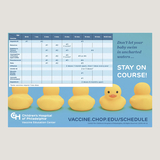Vaccine Schedule: Timetable
The following lists provide suggested timetables for vaccinations from birth through adulthood. Although vaccine schedules can differ slightly, you can generally expect the following vaccines at the ages indicated below.
Infant to 2 years old
Hepatitis B
First dose: at birth
Second dose: 1 to 2 months
Third dose: 6 to 18 months
Rotavirus
First dose: 2 months
Second dose: 4 months
Third dose: 6 months. Depending on the type of rotavirus vaccine used, the third dose may be omitted.
Diphtheria/tetanus/pertussis (DTaP)
First dose: 2 months
Second dose: 4 months
Third dose: 6 months
Fourth dose: 15-18 months
Haemophilus influenzae type b (Hib)
First dose: 2 months
Second dose: 4 months
Third dose: 6 months (Depending on version of vaccine received, this dose may be omitted.)
Third or Fourth dose: 12-15 months
Pneumococcal
First dose: 2 months
Second dose: 4 months
Third dose: 6 months
Fourth dose: 12-15 months
Polio
First dose: 2 months
Second dose: 4 months
Third dose: 6 to 18 months
Influenza
Influenza vaccine is recommended for children beginning at 6 months of age. Two doses one month apart should be given initially, then one dose every year.
COVID-19
COVID-19 vaccine is recommended for children beginning at 6 months of age. Two or three doses should be received, depending on brand of vaccine administered.
Measles/mumps/rubella (MMR)
First dose: 12-15 months
Varicella (chickenpox)
First dose: 12-15 months
Hepatitis A
Two doses six months apart: 12-23 months
4 to 6 years of age
Diphtheria/tetanus/pertussis (DTaP)
One booster dose: 4-6 years (fifth dose of life)
Polio
One booster dose: 4-6 years (fourth dose of life)
Measles/mumps/rubella (MMR)
One booster dose: 4-6 years (second dose of life)
Varicella (chickenpox)
One booster dose: 4-6 years (second dose of life)
Influenza
One dose annually (if previously received)
COVID-19
One dose
9 to 18 years of age
Influenza
One dose annually (if previously received)
COVID-19
One or two doses (depending on brand)
Tetanus/diphtheria/pertussis (Tdap)
One dose: 11-12 years
Human papillomavirus (HPV)
First dose: 11-12 years
Second dose: 6-12 months after first dose
Note: This vaccine can be given as early as 9 years of age. Teens starting this vaccine when they are 15 years or older need three doses. The second dose should be given one to two months after the first dose, and the third dose should be given six to 12 months after the first dose.
Meningococcal (ACWY)
First dose: 11-12 years
Second dose: 16
Note: Teens 16 to 18 years old and those starting college and military recruits who were not previously vaccinated should receive one dose.
Meningococcal (B)
First dose: 16-18 years
Second dose: Six months after dose #1
Note: In some situations, such as in scenarios when a second dose is given sooner than at 6 months (e.g., before starting college) and for immune-compromised teens, three doses will be recommended with the second dose administered one to two months after the first dose, and the third dose six months after the first dose. Talk to your child’s doctor if you have questions about the number of doses your child will need.
The Vaccines and Teens: The Busy Social Years booklet provides a sheet on page 34 for recording your adolescent or teen’s vaccines (also available in Spanish).
Adults
Some adults incorrectly assume that the vaccines they received as children will protect them for the rest of their lives. Generally, this is true, except that:
- Some adults were never vaccinated as children.
- Scientific discoveries are always being made, so some vaccines were not around when a portion of the population was young.
- The immunity provided by some childhood vaccines begins to fade over time.
- Adults become more susceptible to serious diseases caused by common infections as they age (for example, influenza, COVID-19 and pneumococcus).
Vaccines for adults regardless of age
- Influenza
- COVID-19
- Varicella (chickenpox)
- Hepatitis B
- Measles, mumps and rubella vaccine (MMR)
- Diphtheria-tetanus-pertussis (Tdap) or diphtheria-tetanus
Vaccines for some adults based on age
- Between 19 and 26 years and for some adults between 27 and 45 years: Human papillomavirus (HPV)
- For those 50 years and older: Shingles, Pneumococcal
- For those 75 years and older: Respiratory syncytial virus (RSV)
Vaccines for some adults based on situational considerations
Some adults are at higher risk of contracting vaccine-preventable diseases or suffering complications due to their short- or long-term health status (examples include pregnancy, cancer treatment, lack of a spleen, asthma), type of employment (working in healthcare or childcare) or activities (smoking, international travel). This list is not exhaustive, so talk with your healthcare provider about whether there are vaccines that you need.
For additional information, check these related resources:
Reference
Reviewed by Paul A. Offit, MD on April 1, 2025
